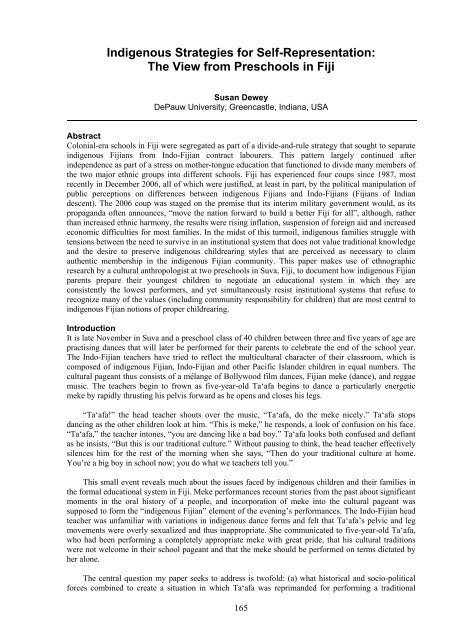traditional knowledge conference 2008 te tatau pounamu
traditional knowledge conference 2008 te tatau pounamu
traditional knowledge conference 2008 te tatau pounamu
Create successful ePaper yourself
Turn your PDF publications into a flip-book with our unique Google optimized e-Paper software.
Indigenous Stra<strong>te</strong>gies for Self-Representation:The View from Preschools in FijiSusan DeweyDePauw University, Greencastle, Indiana, USAAbstractColonial-era schools in Fiji were segrega<strong>te</strong>d as part of a divide-and-rule stra<strong>te</strong>gy that sought to separa<strong>te</strong>indigenous Fijians from Indo-Fijian contract labourers. This pat<strong>te</strong>rn largely continued af<strong>te</strong>rindependence as part of a stress on mother-tongue education that functioned to divide many members ofthe two major ethnic groups into different schools. Fiji has experienced four coups since 1987, mostrecently in December 2006, all of which were justified, at least in part, by the political manipulation ofpublic perceptions on differences between indigenous Fijians and Indo-Fijians (Fijians of Indiandescent). The 2006 coup was staged on the premise that its in<strong>te</strong>rim military government would, as itspropaganda of<strong>te</strong>n announces, “move the nation forward to build a bet<strong>te</strong>r Fiji for all”, although, ratherthan increased ethnic harmony, the results were rising inflation, suspension of foreign aid and increasedeconomic difficulties for most families. In the midst of this turmoil, indigenous families struggle with<strong>te</strong>nsions between the need to survive in an institutional sys<strong>te</strong>m that does not value <strong>traditional</strong> <strong>knowledge</strong>and the desire to preserve indigenous childrearing styles that are perceived as necessary to claimauthentic membership in the indigenous Fijian community. This paper makes use of ethnographicresearch by a cultural anthropologist at two preschools in Suva, Fiji, to document how indigenous Fijianparents prepare their youngest children to negotia<strong>te</strong> an educational sys<strong>te</strong>m in which they areconsis<strong>te</strong>ntly the lowest performers, and yet simultaneously resist institutional sys<strong>te</strong>ms that refuse torecognize many of the values (including community responsibility for children) that are most central toindigenous Fijian notions of proper childrearing.IntroductionIt is la<strong>te</strong> November in Suva and a preschool class of 40 children between three and five years of age arepractising dances that will la<strong>te</strong>r be performed for their parents to celebra<strong>te</strong> the end of the school year.The Indo-Fijian <strong>te</strong>achers have tried to reflect the multicultural charac<strong>te</strong>r of their classroom, which iscomposed of indigenous Fijian, Indo-Fijian and other Pacific Islander children in equal numbers. Thecultural pageant thus consists of a mélange of Bollywood film dances, Fijian meke (dance), and reggaemusic. The <strong>te</strong>achers begin to frown as five-year-old Ta‘afa begins to dance a particularly energeticmeke by rapidly thrusting his pelvis forward as he opens and closes his legs.“Ta‘afa!” the head <strong>te</strong>acher shouts over the music, “Ta‘afa, do the meke nicely.” Ta‘afa stopsdancing as the other children look at him. “This is meke,” he responds, a look of confusion on his face.“Ta‘afa,” the <strong>te</strong>acher intones, “you are dancing like a bad boy.” Ta‘afa looks both confused and defiantas he insists, “But this is our <strong>traditional</strong> culture.” Without pausing to think, the head <strong>te</strong>acher effectivelysilences him for the rest of the morning when she says, “Then do your <strong>traditional</strong> culture at home.You’re a big boy in school now; you do what we <strong>te</strong>achers <strong>te</strong>ll you.”This small event reveals much about the issues faced by indigenous children and their families inthe formal educational sys<strong>te</strong>m in Fiji. Meke performances recount stories from the past about significantmoments in the oral history of a people, and incorporation of meke into the cultural pageant wassupposed to form the “indigenous Fijian” element of the evening’s performances. The Indo-Fijian head<strong>te</strong>acher was unfamiliar with variations in indigenous dance forms and felt that Ta‘afa’s pelvic and legmovements were overly sexualized and thus inappropria<strong>te</strong>. She communica<strong>te</strong>d to five-year-old Ta‘afa,who had been performing a comple<strong>te</strong>ly appropria<strong>te</strong> meke with great pride, that his cultural traditionswere not welcome in their school pageant and that the meke should be performed on <strong>te</strong>rms dicta<strong>te</strong>d byher alone.The central question my paper seeks to address is twofold: (a) what historical and socio-politicalforces combined to crea<strong>te</strong> a situation in which Ta‘afa was reprimanded for performing a <strong>traditional</strong>165
















